-
 Bitcoin
Bitcoin $106,754.6083
1.33% -
 Ethereum
Ethereum $2,625.8249
3.80% -
 Tether USDt
Tether USDt $1.0001
-0.03% -
 XRP
XRP $2.1891
1.67% -
 BNB
BNB $654.5220
0.66% -
 Solana
Solana $156.9428
7.28% -
 USDC
USDC $0.9998
0.00% -
 Dogecoin
Dogecoin $0.1780
1.14% -
 TRON
TRON $0.2706
-0.16% -
 Cardano
Cardano $0.6470
2.77% -
 Hyperliquid
Hyperliquid $44.6467
10.24% -
 Sui
Sui $3.1128
3.86% -
 Bitcoin Cash
Bitcoin Cash $455.7646
3.00% -
 Chainlink
Chainlink $13.6858
4.08% -
 UNUS SED LEO
UNUS SED LEO $9.2682
0.21% -
 Avalanche
Avalanche $19.7433
3.79% -
 Stellar
Stellar $0.2616
1.64% -
 Toncoin
Toncoin $3.0222
2.19% -
 Shiba Inu
Shiba Inu $0.0...01220
1.49% -
 Hedera
Hedera $0.1580
2.75% -
 Litecoin
Litecoin $87.4964
2.29% -
 Polkadot
Polkadot $3.8958
3.05% -
 Ethena USDe
Ethena USDe $1.0000
-0.04% -
 Monero
Monero $317.2263
0.26% -
 Bitget Token
Bitget Token $4.5985
1.68% -
 Dai
Dai $0.9999
0.00% -
 Pepe
Pepe $0.0...01140
2.44% -
 Uniswap
Uniswap $7.6065
5.29% -
 Pi
Pi $0.6042
-2.00% -
 Aave
Aave $289.6343
6.02%
What does it mean when the KD indicator is continuously blunted above 80?
A blunted KD indicator above 80 in crypto suggests strong bullish momentum but requires caution as overbought conditions can persist or signal potential reversals.
Jun 19, 2025 at 03:56 pm
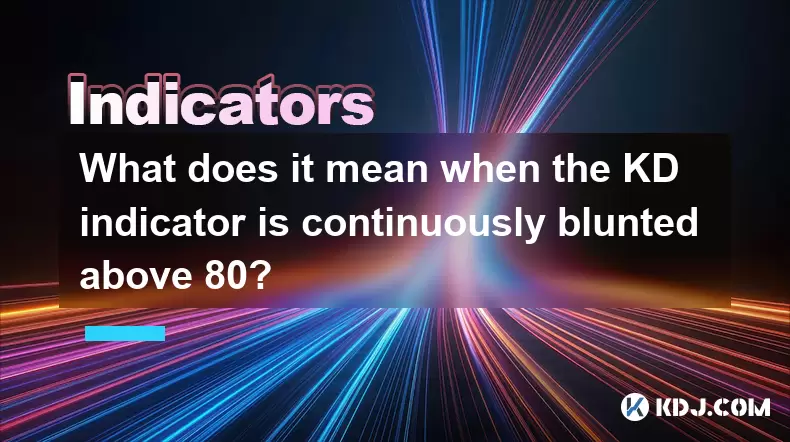
Understanding the KD Indicator in Cryptocurrency Trading
The KD indicator, also known as the Stochastic Oscillator, is a momentum oscillator used in technical analysis to assess overbought and oversold conditions. In the context of cryptocurrency trading, it plays a crucial role in evaluating price trends and potential reversal points. The KD indicator consists of two lines: the %K line and the %D line. These lines oscillate between 0 and 100, providing traders with signals about market momentum.
When the KD indicator reaches levels above 80, it typically indicates that an asset is overbought. This means that the price has been consistently rising and may be due for a correction or pullback. However, when this level remains sustained — that is, when the indicator is continuously blunted above 80 — it raises questions among traders about the strength of the trend and the likelihood of a reversal.
What Does "Blunted" Mean in the Context of the KD Indicator?
In technical analysis terminology, a blunted KD indicator refers to a situation where the %K and %D lines remain at extreme levels (above 80 or below 20) without showing significant movement back toward neutral territory. When this occurs above 80, it suggests that buying pressure has been persistent and strong enough to keep prices elevated for an extended period.
This phenomenon is particularly interesting in the volatile world of cryptocurrencies. Unlike traditional markets, crypto assets can sustain overbought conditions for longer durations during strong bull runs or periods of intense speculation. Therefore, a blunted KD above 80 does not necessarily mean an immediate sell-off but rather highlights a potential imbalance between buyers and sellers.
How to Interpret Continuous Bluntness Above 80 in Crypto Markets
- Strong Uptrend Confirmation: A prolonged stay above 80 may indicate that the asset is in a powerful uptrend driven by strong buyer sentiment.
- Momentum Sustained by FOMO: Fear of Missing Out (FOMO) often fuels rapid price increases in crypto markets, which can cause indicators like KD to remain overbought for long stretches.
- Caution Against Blind Selling: Many novice traders interpret overbought levels as automatic sell signals, but in crypto, this can lead to missed gains if the trend continues.
- Watch for Divergence: If the price continues to rise while the KD starts to decline from above 80, it could signal weakening momentum and an upcoming reversal.
It's essential to remember that no single indicator should be used in isolation. Traders should combine the KD reading with other tools such as volume analysis, moving averages, and support/resistance levels for more accurate assessments.
Practical Steps to Analyze KD Bluntness in Real-Time Charts
To effectively monitor and respond to a KD indicator that remains above 80, follow these practical steps:
- Set Up Your Charting Tool: Use platforms like TradingView, Binance’s native chart, or CoinMarketCap Pro to display the KD indicator on your preferred time frame.
- Adjust Settings if Necessary: The default setting for the Stochastic is usually (14, 3, 3). You can experiment with shorter or longer periods depending on your trading strategy.
- Overlay Price Action: Pay attention to how price behaves while the KD stays above 80. Is it forming higher highs? Are there signs of exhaustion like long wicks or decreased volume?
- Look for Crossovers: Even within overbought territory, crossovers between the %K and %D lines can provide short-term signals. For instance, a bearish crossover might hint at profit-taking opportunities.
- Monitor Volume: High volume during KD bluntness supports the continuation of the trend, while declining volume may suggest weakening momentum.
By applying these techniques, traders can better understand whether the current overbought condition is sustainable or likely to reverse.
Risks Associated with Ignoring KD Bluntness in Crypto Trading
While staying above 80 doesn't always mean a reversal is imminent, ignoring this condition can pose several risks:
- Overexposure During Blow-Off Tops: Some crypto rallies end abruptly after extended overbought phases. Holding positions too long during these periods can result in sharp losses.
- False Breakouts: Momentum-driven moves can create false breakouts above resistance levels, especially when the KD is already stretched.
- Psychological Pressure: Watching the KD stay high for days can create uncertainty and emotional decision-making if not properly contextualized with other data.
- Lack of Exit Signals: Without additional tools, traders may struggle to find optimal exit points when the KD remains in overbought territory.
Therefore, even though the KD being continuously blunted above 80 can reflect strong bullish momentum, it should not be ignored as a potential risk signal in itself.
FAQs Related to KD Indicator Bluntness in Cryptocurrency
Q: Can the KD indicator stay above 80 indefinitely in crypto markets?
A: Yes, especially during parabolic moves or hype-driven rallies. Cryptocurrencies are known for their volatility and tendency to defy traditional technical signals temporarily.
Q: Should I sell every time the KD goes above 80?
A: No. While overbought readings can suggest caution, they don’t guarantee reversals. It’s important to analyze the broader context including volume, trendlines, and market sentiment before making decisions.
Q: What time frames are best for observing KD bluntness?
A: Higher time frames like 4-hour or daily charts are more reliable for identifying sustained overbought conditions. Shorter time frames can give misleading or choppy signals.
Q: How does the KD compare to RSI in crypto trading?
A: Both measure momentum, but the RSI focuses on speed and change of price movements, while the KD compares closing prices to a range. In crypto, KD can sometimes give earlier signals than RSI, especially in fast-moving markets.
Disclaimer:info@kdj.com
The information provided is not trading advice. kdj.com does not assume any responsibility for any investments made based on the information provided in this article. Cryptocurrencies are highly volatile and it is highly recommended that you invest with caution after thorough research!
If you believe that the content used on this website infringes your copyright, please contact us immediately (info@kdj.com) and we will delete it promptly.
- BAY Miner & XY Miners: Unlock Daily Earnings with BTC, DOGE, and LTC Cloud Mining
- 2025-06-20 10:25:12
- Decoding the Aaluxx Myth: Maya Protocol and the Smart Economy
- 2025-06-20 10:30:12
- Binance Wallet, Exclusive Token, Launch: What You Need to Know
- 2025-06-20 10:45:12
- Semler Scientific's Bitcoin Bet: Bold Move or Risky Gamble?
- 2025-06-20 10:50:12
- SHIB Eyes on Whale Activity and Shibarium Upgrade: Will It Trigger a Reversal?
- 2025-06-20 10:50:12
- Crypto Bull Run Expert Prediction: Navigating the Generational Surge
- 2025-06-20 08:25:12
Related knowledge
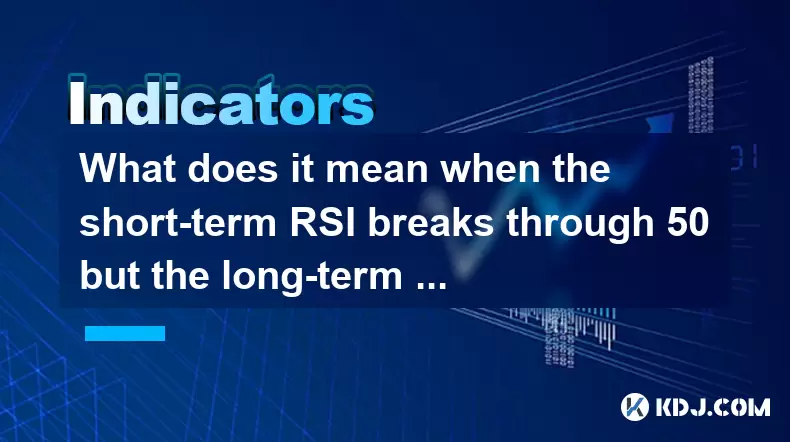
What does it mean when the short-term RSI breaks through 50 but the long-term RSI does not move in the RSI indicator?
Jun 20,2025 at 10:42am
Understanding the RSI Indicator and Its Dual-Term ApplicationThe Relative Strength Index (RSI) is a widely used momentum oscillator in technical analysis, primarily for identifying overbought or oversold conditions in an asset’s price movement. It typically operates on a scale from 0 to 100, with levels above 70 considered overbought and below 30 consid...
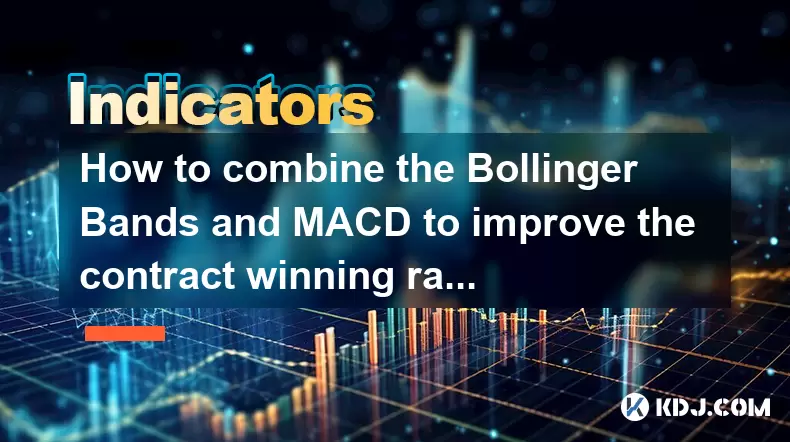
How to combine the Bollinger Bands and MACD to improve the contract winning rate?
Jun 19,2025 at 06:35pm
Understanding Bollinger Bands and MACD IndicatorsTo effectively combine Bollinger Bands and the MACD (Moving Average Convergence Divergence), it's essential to first understand what each indicator represents. Bollinger Bands consist of a middle moving average line and two outer bands that adjust based on market volatility. When prices move toward the up...
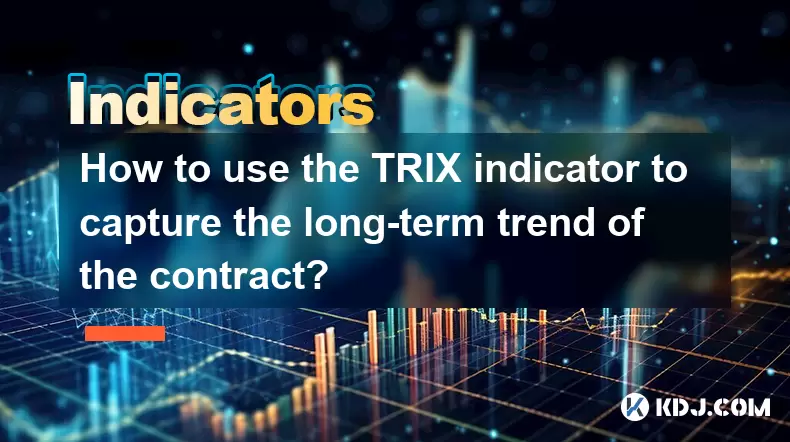
How to use the TRIX indicator to capture the long-term trend of the contract?
Jun 20,2025 at 09:14am
What Is the TRIX Indicator?The TRIX (Triple Exponential Average) indicator is a momentum oscillator used to identify oversold and overbought conditions, as well as potential trend reversals in financial markets. It is calculated by applying a triple exponential moving average to price data and then taking the percentage rate of change of that smoothed v...

How does the long lower shadow of the K line indicate the formation of the bottom of the contract?
Jun 19,2025 at 05:00am
Understanding the Long Lower Shadow in K-Line AnalysisIn cryptocurrency trading, K-line analysis plays a pivotal role in determining market sentiment and potential price reversals. A long lower shadow, also known as a long wick, is one of the most telling candlestick patterns that traders look for when assessing whether a bottom might be forming in a co...
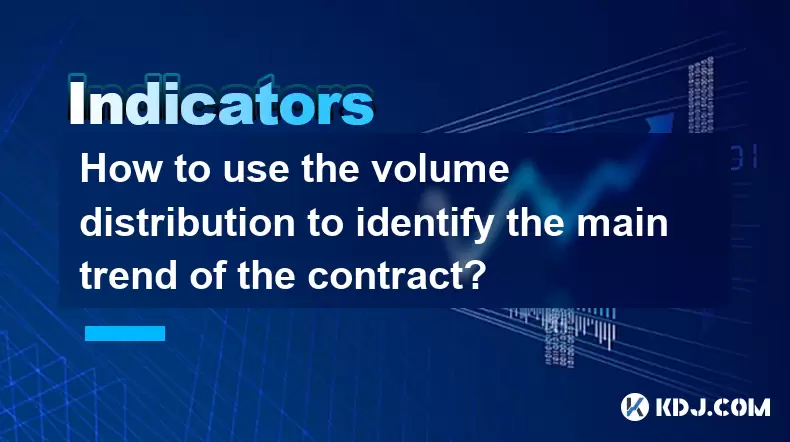
How to use the volume distribution to identify the main trend of the contract?
Jun 20,2025 at 03:56am
Understanding Volume Distribution in Cryptocurrency ContractsIn the realm of cryptocurrency trading, particularly within futures and perpetual contracts, volume distribution plays a pivotal role in deciphering market sentiment. Unlike spot markets, contract trading involves leveraged positions that can amplify both gains and losses. To navigate this com...
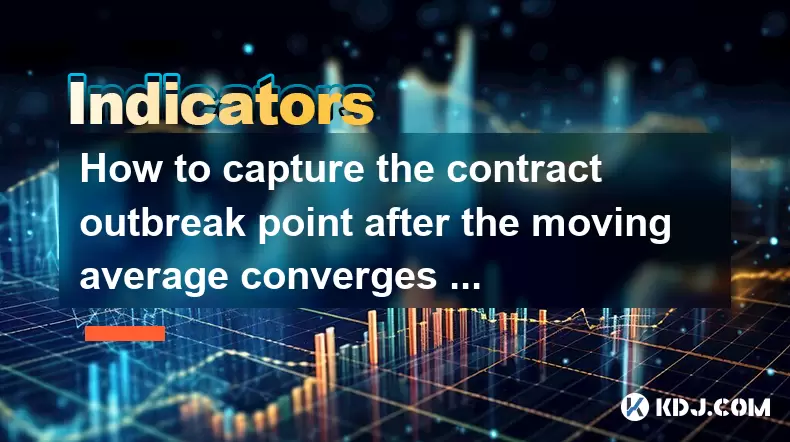
How to capture the contract outbreak point after the moving average converges and diverges?
Jun 19,2025 at 02:07pm
Understanding Moving Average Convergence and Divergence in Crypto TradingIn cryptocurrency trading, moving averages are among the most widely used technical indicators. The concept of convergence and divergence refers to how different moving averages align or separate over time. When short-term and long-term moving averages come together (converge), it ...

What does it mean when the short-term RSI breaks through 50 but the long-term RSI does not move in the RSI indicator?
Jun 20,2025 at 10:42am
Understanding the RSI Indicator and Its Dual-Term ApplicationThe Relative Strength Index (RSI) is a widely used momentum oscillator in technical analysis, primarily for identifying overbought or oversold conditions in an asset’s price movement. It typically operates on a scale from 0 to 100, with levels above 70 considered overbought and below 30 consid...

How to combine the Bollinger Bands and MACD to improve the contract winning rate?
Jun 19,2025 at 06:35pm
Understanding Bollinger Bands and MACD IndicatorsTo effectively combine Bollinger Bands and the MACD (Moving Average Convergence Divergence), it's essential to first understand what each indicator represents. Bollinger Bands consist of a middle moving average line and two outer bands that adjust based on market volatility. When prices move toward the up...

How to use the TRIX indicator to capture the long-term trend of the contract?
Jun 20,2025 at 09:14am
What Is the TRIX Indicator?The TRIX (Triple Exponential Average) indicator is a momentum oscillator used to identify oversold and overbought conditions, as well as potential trend reversals in financial markets. It is calculated by applying a triple exponential moving average to price data and then taking the percentage rate of change of that smoothed v...

How does the long lower shadow of the K line indicate the formation of the bottom of the contract?
Jun 19,2025 at 05:00am
Understanding the Long Lower Shadow in K-Line AnalysisIn cryptocurrency trading, K-line analysis plays a pivotal role in determining market sentiment and potential price reversals. A long lower shadow, also known as a long wick, is one of the most telling candlestick patterns that traders look for when assessing whether a bottom might be forming in a co...

How to use the volume distribution to identify the main trend of the contract?
Jun 20,2025 at 03:56am
Understanding Volume Distribution in Cryptocurrency ContractsIn the realm of cryptocurrency trading, particularly within futures and perpetual contracts, volume distribution plays a pivotal role in deciphering market sentiment. Unlike spot markets, contract trading involves leveraged positions that can amplify both gains and losses. To navigate this com...

How to capture the contract outbreak point after the moving average converges and diverges?
Jun 19,2025 at 02:07pm
Understanding Moving Average Convergence and Divergence in Crypto TradingIn cryptocurrency trading, moving averages are among the most widely used technical indicators. The concept of convergence and divergence refers to how different moving averages align or separate over time. When short-term and long-term moving averages come together (converge), it ...
See all articles

























































































